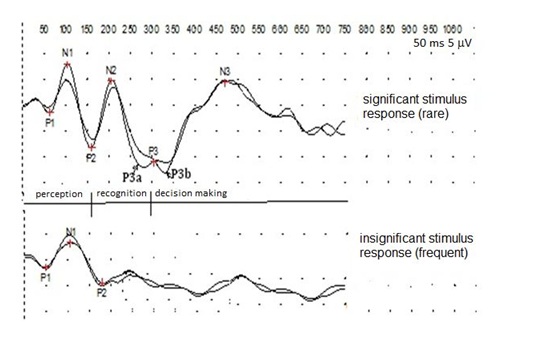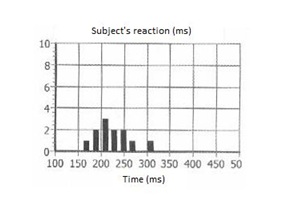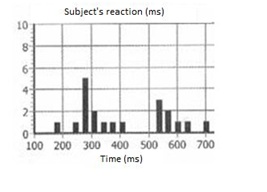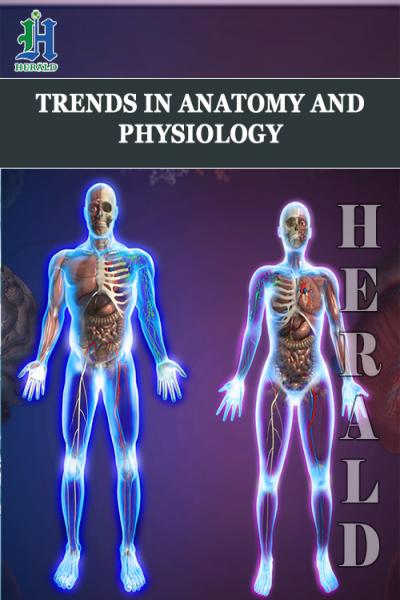
Time of Reaction in Using the Pushing of Button in Experiment of Evoked Cognitive Potentials (R300)
*Corresponding Author(s):
Klochkova OIPublic Health School Of Pacific State Medical University, Vladivostok, Russian Federation
Tel:+7 375292841370,
Email:klochkova_olga@bk.ru
Abstract
Background
Evoked cognitive potentials are a promising experimental technique that can be useful in diagnosis of various cognitive disorders, especially connected to the various memory impairments. Of particular interest to researchers is the study of the cognitive evoked potentials’ latency when recognition of various stimuli is involved.
Objective
The method of Luria was used to determine the volume of verbal memory. To study the physiological nature and functional role of evoked cognitive potentials observed during the reaction to stimuli, and to determine the degree of conscious control involved in this reaction. To do so the experimental data were statistically analyzed to determine the numerical correlation between the working memory capacity and the cognitive potential’s latency.
Design
The cognitive Eps were measured for 166 healthy subjects and 63 others that had some pathological brain condition (circulatory encephalopathy and other brain circulatory disorders), varied by the age and gender. Measurements were done with the Neurosoft Neuro-MVP 4 computerized encephalography system, which implemented the standard method of large latency neural response measurement for P300 waves. Measurements were done in the setup where the subject had to recognize the significant stimuli and react to them by pressing a button. The significant stimulus was represented by a 2 kHz tone, while the insignificant stimuli were the frequently repeated 1 kHz tones. The brainwaves were registered in Cz-M1 and Cz-M2 outputs. This method allowed detection and latency measurements of the main response components N2, P3a and N3. Working memory capacity was determined by the number of words from a 10-15 word sets correctly reproduced shortly after exposures, as outlined by Luria.
Results
A statistically significant non-linear correlation was observed between the memory capacity and the EP’s latency, which was fitted by a modified hyperbolic function. Additionally, greater latencies were observed for subjects suffering from the memory disorders, and much shorter latencies were in general noted for the male subjects as opposed to the female ones. One more interesting observation was that in many cases the absolute reaction time was less than the cognitive potential peak taken as a conscious decision, suggesting that it is in many cases an automatic reaction. Conclusions: This cognitive potentials measurement, being an instrumental method, allows a clinical psychologist much greater flexibility in his diagnostic repertory, as it can be used even in the cases where word tests cannot. Also, the reaction time shorter than the latency of conscious reaction to stimuli adds weight to the simultaneous codes theory of automatic reactions.
Keywords
INTRODUCTION
The stages of information now are measured by Event-Related Potentials (ERPs) or evoked potentials. The tasks that are used to elicit ERPs cover a big variety of human sensory, motor, and cognitive functions [1]. Together with the sensory evoked potentials a lot of research is aimed at the cognitive EPs that appear when the subject recognizes a significant stimulus with a typical latency of 300 ms. This is usually detected when the subject has to consciously react (as in doing a calculation or pressing a button) to a rarely repeated stimulus as a positive so-called P3 or P300 wave (Figure 1) [2-6]. The neural response parameters, chiefly of this P300 peak, are dependent on a subject’s age, conforming to the so-called aging curve, with the latency significantly increasing with the age [3,7,8]. The latency and the amplitude of the P300 peak are frequently used to estimate the memory and attention characteristics in clinical practice [3,4,9-17].
 Figure 1: Cognitive evoked potentials for a 49 y.o. male.
Figure 1: Cognitive evoked potentials for a 49 y.o. male.
The most diagnostically significant parameters of a P300 wave are its aforementioned latency period (LP thereafter) and amplitude. Most cognitive disorders are manifested as the LP elongation and the amplitude decrease [3,11,18], however the latter is less significant as P300 height is variable and can easily decrease with the reduced attention even in the absence of any pathological process [3-5,10,11,19]. Two neural response plots are demonstrated for a significant (above) and insignificant (below) stimuli respectively, superimposed for the variability estimation [8,10,11,20,21].
Insignificant stimuli only generate a first, sensory peak (N1), while the reaction to a significant stimulus leads to a detection of a whole cognitive complex including a P300 (P3) peak with the average latency or 305 ms. EP curve manifests several characteristic peaks: N2, P3 and N3. P3’s appearance might be connected to a working memory refresh [3,7,22], or the beginning of a decision process [23]. The cognitive process frequently gets modified by the “folding”(the convolution ) of simultaneous code cognitive procedures in this case [3,22], leading to the performance increase, but also the possible loss of a conscious control of the process.: The method of Luria was used to determine the volume of verbal memory [24].
There exist cases where a hypnotized or feverish person could remember in detail the circumstances encountered decades ago, including the texts in unknown foreign languages, which obviously suggest the unconscious activation of a long-time memory. In this work the working memory is interpreted in a multi-component model that includes a central processing node controlled by an attention system [12], variable-sized event buffer and the long-time memory interface, that is, a modification of a well-known three-component model with a phonological loop, spatial information entry system and main operator. The goal of this work is the determination of the degree of consciousness in the decision to press the button when encountering a respective stimulus [12], based on a physiological study of the evoked brain potentials and their role in the process of a significant stimuli recognition.
One of the task connected to the aforementioned goal, is a determination of the non-linear correlation between the verbal Working Memory Capacity (WMC) and the LP300 neural response latency in the mixed sample of the healthy subjects and those suffering from memory disorders.
The second task is a determination of a degree of consciousness in the decision to press a button, which is based on a neural response graph and reaction time comparison between the 28 healthy adult subjects varying in age and gender (16 females and 12 males).
The standard cognitive EP detection experiment can be represented by the so-called oddball paradigm.(In 1978 Risto Nataanen discovered an ERP component named Mismatch Negativity (MMN) that was attention independent and appeared in response to rare deviant stimuli when compared with ERPs to standard stimuli in the ODDBALL paradigm.) According to a standard interpretation, the mismatch between the significant stimulus and the memory image left by the repeating insignificant standard stimuli generates a negative mismatch signal that increase the negative amplitude of a front-central derivation. Here authors point three peaks in the cognitive EP curve, with the characteristic latencies of 116 ms [4], 132 mas, and 236 ms. The last peak is characterized by an additional positive component and is localized at the anterior cingulate gyrus. Thus, if the stimulus doesn’t match the memory image, formed by the previous repetitive stimulation, a strongly negative response is generated, which is then followed by a positive one. The P3a components is usually linked with an orientation reflex when a sensory model of the environment, kept in a brain’s sensory system, is rebuilt. This mechanism is unconscious [1], and allows the individual to adapt when their environment changes. The P300 component of the event-related potential is a large positive waveform that can be extracted from the ongoing electroencephalogram using a two-stimuli oddball paradigm, and has been associated with cognitive information processing (e.g. memory, attention, executive function)It is hypothesized that latency and amplitude index different aspects of brain maturation. The P300 latency possibly indexes neural speed or brain efficiency. The P300 amplitude might index neural power or cognitive resources, which increase with maturation [25].
Experimental methods: Aside from the above mentioned 28 healthy subjects, cognitive EPs were also measured, and P300/WMC analyzed, for 138 additional subjects, of which 75 were healthy, while 63 others had some pathological brain condition (circulatory encephalopathy and other brain circulatory disorders), varied by the age and gender.
Measurements were done with the Neurosoft Neuro-MVP 4 computerized encephalography system at the Clinical Neurophysiology lab of the Neurology Scientific Center in Moscow, which implemented the standard method of large latency neural response measurement for P300 waves. Measurements were done in the setup where the subject had to recognize the significant stimuli and react to them by pressing a button. The significant stimulus was represented by a 2 kHz tone, while the insignificant stimuli were the frequently repeated 1 kHz tones. The brainwaves were registered in Cz-M1 and Cz-M2 derivations. This method allowed detection and latency measurements of the main response components N2, P3 and N3 [22,3].
Working memory capacity was determined by the number of words from a 10-15 word sets correctly reproduced shortly after exposures, as outlined by Luria in [24] and Revenok in [8]. Data were analyzed using the statistical 10 and excel 2010 software. From the subjects’ reaction time histograms (Figures 2 and 3) the reaction time for each button press was extracted. The percentage of the fast presses (where the LP parameter of the evoked potential curve was less than the reaction time) is shown in the table 1.If the button was pressed before the conscious decision to press was made (Figure1), therefore, action was done unconsciously. For the male subjects this percentage was no less than 84%, for example for the Subject M, whose reaction time histogram is shown in the Fig. 6, the fast presses constituted 90% of the whole set. On the other hand, female subject had shown much smaller rate of the fast presses, no more than 69%, and the Subject F from the figure 3 had only 36% of the fast presses.
|
Subject |
Age |
LP P3 (ms) |
Fast press rate (RT |
LP N2 (ms) |
Reaction time (ms) |
|
Male (average) |
40.3±13.7 |
343,42±27,86 |
84,6%-95,3% |
229,54±34,00 |
295,59±48,30 |
|
M |
44 |
325,3±10,6 |
90% - 85% |
207,5 |
242,5±19,09 |
|
Female (average) |
36.4±11.7 |
343,19±28,64 |
30%-69% |
234,19±27,27 |
300,59±58,30 |
|
F |
58 |
373±21,21 |
36%-50% |
180 |
407,5±10,61 |
Table 1: The reaction time in the standard experiment to measure cognitiveevoked potential.
 Figure 2: The Subject M’s reaction time histogram.
Figure 2: The Subject M’s reaction time histogram.
 Figure 3: The Subject F’s reaction time histogram.
Figure 3: The Subject F’s reaction time histogram.
Comparing the reaction time histograms with the EP curves latency, it is evident that for the male Subject M (Figure 2) the histogram is compact and has a distinct peak in the 210-230 ms range, which is less than the average EP peak latency of 325.3 ms (Table 1). Conversely, for the female subject F the reaction time histogram has a multi-modal shape, with the largest peak in the 250 -290 ms range, which is also less than the EP latency (373 ms).
Thus, not all histogram peaks fall into the reaction time interval (Table 1), with the outliers appearing outside it for both male (Figure 2) and female (Figure 3) subjects.
DISCUSSION
The problems of cognition and cognitive disorders are widely discussed in literature. The known dependence of cognitive potential and working memory capacity on the subject’s age on the one hand [3,7,12,17,26-29], and the connection between the subject’s age and the number of neurons used for learning on the other one [3,722,30] implies an existence of the connection between WMC and the LP300 latency. This work experimentally demonstrates this connection and determines it’s character depending not only on the subject’s age, but also on the other characteristics.
It’s been demonstrated earlier that the LP300 increases linearly with the decreasing working memory capacity in the patients suffering from cognitive disorders. This paper builds on this work, demonstrating that the better correlation between the latency and the Luria-test measured memory capacity might be obtained if the compound hyperbola is used to fit the experimental data instead of the linear fit, especially if the latency parameter is less than 350 milliseconds [7,26].
Conversely, this means that the latency parameters might be used to indirectly estimate the working memory capacity from the experimentally measured cognitive potential latency without taking word tests. As a strong correlation between those parameters shows the validity of such a method, this allows using it in the cases when a word-based psycho logic testing is impossible, which might be an advantage in certain circumstances. These results also match the hypothesis of the linked simultaneous codes and the model of psycho logic operations in the working memory [24]. It is possible that all stages of psychological operation might be folded into a linked simultaneous code that can be unconsciously invoked after a repeated stimuli [1], as suggested by the percentage of the fast (potentially, not consciously controlled) button presses in table 1. This might be the mechanism of the unconscious multitasking between the routine operations, like thinking of something disconnected while driving, and returning to the conscious control when the circumstances require it.
CONCLUSION
- Working memory capacity and evoked cognitive potentials latency (P300 peak) data obtained for a sample of 138 subjects of varied ages between 10 and 90 years. The method of Luria was used to determine the volume of verbal memory.
- Identified a possibility to estimate a working memory capacity from the measured latency parameters without taking a word test.
- The reaction time to a stimulus is often less than a cognitive potential latency, suggesting an unconscious reaction.
REFERENCES
- Kropotov YD (2009) Quantitative EEG,event-related potentials and neurotherapy, Elsevier, California, USA.
- Klochkova OI, Gnezditskiy VV (2018) Use of cognitive evoked potentials (P300) as an approach to assessing the frequency of possible requests towards the working memory of players during computer games. Human Physiology 44: 15-23.
- Gnezditsky VV, Korepina OS (2011) Brain’s evoked potentials handbook (a practical handbook based on clinical observations). PresSto, Ivanovo, Russia.
- Näätänen R, Paavilainen P, Rinne T, Alho K (2007) The Mismatch Negativity (MMN) in basic research of central auditory processing: A review. Clin Neurophysiol 118: 2544-25¬90.
- Revenok EV, Grezditsky VV, Korepina OS (2001) Vyzvannyepotentsialy v otsenkestareniya i dementsii [Evoked potentials in the estimates of aging and dementia] in Gnezditsky VV, Shamshinova AM (Eds.) Opytprimeneniyavyzvannyakhpotentsialov v klinicheskoypraktike [An attempt of applicantion of invoked potential in clinical practice] Moscow: Antidor.
- Goodin DS, Martin S (1992) P300, cognitive capability, and personality: A correlational study of university undergraduates. Person individ Diff 13: 533-543.
- Gnezditsky VV, Revenok EV, Korepina OS, Kalashnikova LA (2001) P300 and neuropsychological profile for cognitive disorders and vascular dementia. Human physiology 27: 42-53.
- Revenok EV (1999) Neurophysiological profile and evoked potentials in the patients with the vascular dementia of cortical and subcortical types. Ph.D thesis. Moscow: self-published.
- Bledowski C, Cohen KK, Wibral M, Rahm B, Bittner RA, et al., (2006) Mental chronometry of working memory retrieval: A combined functional magnetic resonance imaging and event-related potentials approach. J Neurosci 26: 821-829.
- Grut M, Jorm AF, Fratiglioni L, Forsell Y, Viitanen M, et al., (1993) Memory complaints of elderly people in a population survey: variation according to dementia stage and depression. J Am Geriatr Soc 41: 1295-1300.
- Juckel G, Clotz F, Frodl T, Kawohl W, Hampel H (2008) diagnostic usefulness of cognitive auditory event-related p300 subcomponents in patients with alzheimers disease? J Clin Neurophysiol 25: 147-152.
- Buddley A, Isaac M, Anderson M (2011) Pamyat [translated from English, ed. Reznikova T.N.] Saint-Petersburg: Piter.
- Klochkova OI (2014) Numerical estimate of working memory short-time episodic buffer usagefor students interacting with a computer. Pacific Journal of Medicine 3: 93-96.
- Klochkova OI, Shabanov GA, Rybchenko AA, Pogorelova IV, Startseva MS (2016) Signs of the brain inertia in spectral function of evoked electromagnetic activity. Pacific Journal of Medicine 4: 26-30.
- Bennys K, Portet F, Touchon J, Rondouin G (2007) Diagnostic value of event-related evoked potentials n200 and p300 subcomponents in early diagnosis of alzheimer's disease and mild cognitive impairment. J Clin Neurophysiol 24: 405-412.
- Kok A (2001) On the utility of P3 amplitude as a measure of processing capacity. Psychophysiology 38: 557-577.
- Pfefferbaum A, Ford JM, Johnson R (1984) Clinical application of P300. EEG and Clin. Neurophysiology 59: 85-116.
- Fjell AM, Walhovd KB, Fischl B, Reinvang I (2007) Cognitive function, P3a/ P3b brain potentials, and cortical thickness in aging. Hum Brain Mapp 28: 1098-1116.
- Kugler CF, Taghavy A, Platt D (1993) The event-related P 300 potential analyses of cognitive human brain aging: A review. J Gerontol 39: 280-303.
- Linden DEJ (2005) The P300: Where in the brain is it produced and what does it tell us? Neuroscientist 11: 563-576.
- McCarthy G, Donchin E (1981) A metric for thought: a comparison of P300 latency and reaction time. Science 211: 77-80.
- Gnezditsky VV, Charskaya AV, Korepina OS, Klochkova OI (2016) Estimates of working memory capacity based on endogenous evoked potentials by P300 method. Annas of clinical neurology 10: 27-34.
- Donchin E, Coles MGH (1988) Is the P300 component a manifestation of context updating? Behav. Behavioral and Brain Sciences 11: 357-374.
- Luria AR (2008) Higher cortex functions in humans. Saint-Petersburg, Piter.
- Dinteren RV, Arns M, Jongsma MLA, Kessels RPC (2014) P300 Development across the lifespan: a systematic review and meta-analysis. PLoS One 9: 87347.
- Zakharov VV (2015) Moderate cognitive disorders as a multidisciplinary problem]. Journal of neurology, neuropatophysiology and psychosomatics 2: 5-10.
- Brazdil M, Dobsik M (2005) Combined event-related fMRI and intracerebral ERP study of evidence. Neuroimage, 20: 1270-1282.
- Miller GF (1956) The magical number seven, plus or minus two, some limits on our capacity for processing information. Psychol Rev 101: 343-352.
- Mulert C, Lemieux L (2010) EEG and Fmri: Physiological basis, technique and application. Springer, Berlin, Germany.
- Shvyrkov VB (1995) Introduction to the objective psychology: Neuronal basis of the mind. RAS Psychology Institute. Moscow, Russia.
Citation: Klochkova OI, Gnezditsky VV (2019) Time of Reaction in Using the Pushing of Button in Experiment of Evoked Cognitive Potentials (R300). Trends Anat Physiol 2: 008.
Copyright: © 2019 Klochkova OI, et al. This is an open-access article distributed under the terms of the Creative Commons Attribution License, which permits unrestricted use, distribution, and reproduction in any medium, provided the original author and source are credited.

